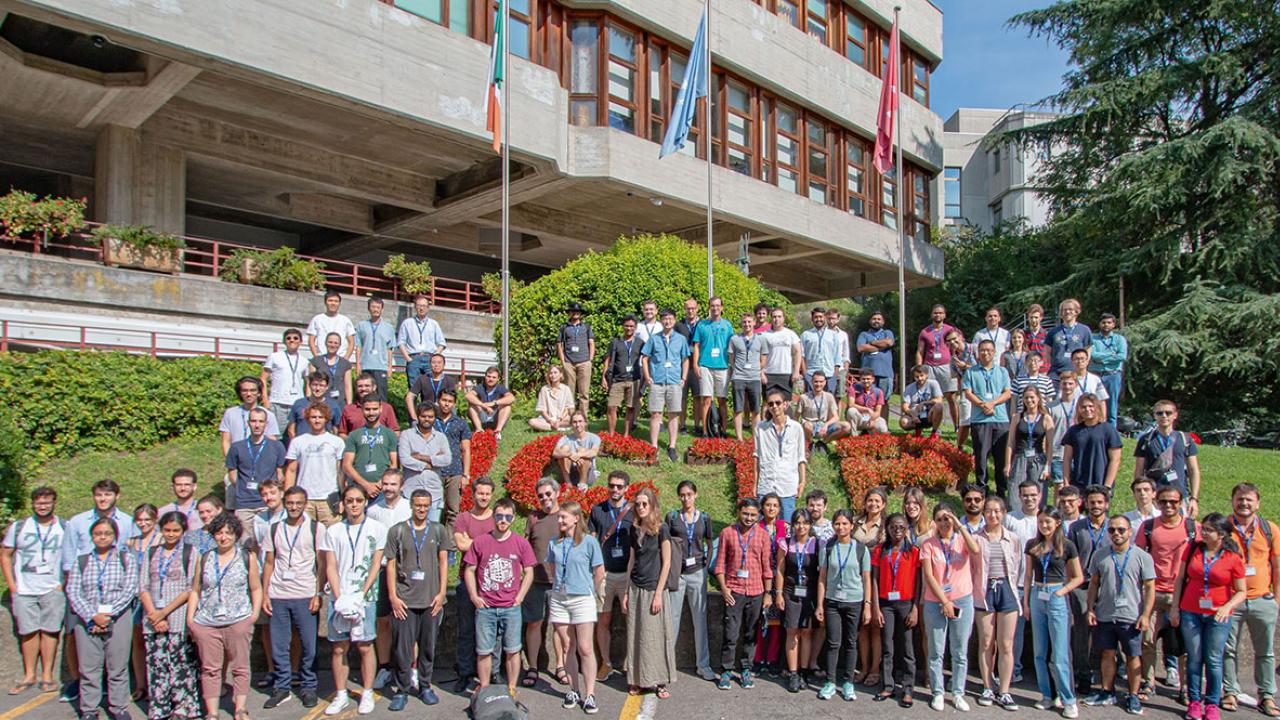
A host of international visitors arrived at ICTP in August to attend a two-week school on Quantum Many-Body Phenomena out of Equilibrium: from Chaos to Criticality, which was sponsored by the Slovenian Research Agency (ARRS), J. Stefan Institute, QuantERA Programme, NextGenerationEU, Ministero dell Istruzione e del Merito, Italia Domani, il Piano Nazionale di Ripresa e Resilienza, SISSA, and the National Quantum Science and Technology Institute (NQSTI).
“The aim of the school was to give an overview of the frontline research in the field of non-equilibrium physics of quantum many-body systems,” says Rosario Fazio, local organiser of the event and head of the Condensed Matter and Statistical Physics section at ICTP. “This is an area of paramount importance, both in terms of our understanding of the fundamentals of statistical physics and for the numerous applications relevant to quantum technologies.”
A range of lectures covered the theory of dynamics close to equilibrium state, many-body quantum chaos, thermalization and scars, the dynamics of disordered systems, scrambling in quantum systems, the dynamics and hydrodynamics of nearly integrable systems, open quantum systems, and measurement-induced phase transitions. Seminars were also provided on numerical methods and experimental platforms used in the field.
Theory of non-equilibrium quantum many-body dynamics
Talks on the theoretical aspects of the field were given by a range of international researchers. One lecture series focused on dynamics close to equilibrium and chaos, delving into the concepts of chaos, ergodicity (the idea that a point in a moving system will uniformly and randomly visit all parts of the space the system moves in) and determinism in classical systems. Talks on measurement-induced phase transitions in monitored quantum dynamics discussed the background to quantum thermalisation, quantum chaos and ergodicity, and ergodicity breaking, and described the non-local effects of measurement and quantum error corrections. Other lectures covered ergodicity and quantum entanglement, providing a detailed look at many-body localisation, quantum thermalization, local thermalisation, spin chains, and anomalous spin fluctuations.
One series focused on phases of matter in periodically-driven, or Floquet, systems; addressing key issues related to these systems, what makes them interesting, and connections to classical dynamical systems. An introductory course on tensor network models was also given, which delved into the history of these networks and their applications; describing what has been done in the last couple of decades, and what could be done in the future.
Talks on numerical and diagrammatic approaches to exploring non-equilibrium phenomena in correlated electron systems described photo-induced dynamics in interacting systems, or “quantum materials.” Another series on the micro- to macro-physics of driven open quantum systems discussed applications that show how the microscopic breaking of equilibrium conditions relates to large-scale observable phenomena.
Numerical systems and experimental platforms
In terms of numerical simulation, one talk described the use of digital quantum simulations with trapped ions. Another discussed the probing of entanglement growth on a Rydberg quantum simulator, addressing the question of whether quantum systems are better at representing highly entangled states of matter than classical systems. Seminars were also given on a type of quantum circuit (model for quantum computation) referred to as a dual unitary circuit.
On the experimental side of the workshop, one seminar described many-body localization under a microscope, while another detailed experimental approaches to the non-equilibrium physics of complex quantum materials, discussing both time-domain spectroscopy and controlling the onset of quantum coherent states in complex materials.
Participants were exposed to a wide range of topics within the field over the two-week school. “Highlights of the school were the excellent lectures that covered different and important aspects of this field,” adds Fazio. “The atmosphere was very lively, as shown by the excellent quality of the poster sessions. I am confident that participants learned about technical aspects and gained a broad vision of the field.”
Details of the workshop may be found at: School on Quantum Many-Body Phenomena out of Equilibrium: from Chaos to Criticality | (smr 3867) (21 August 2023 - 1 September 2023).
















